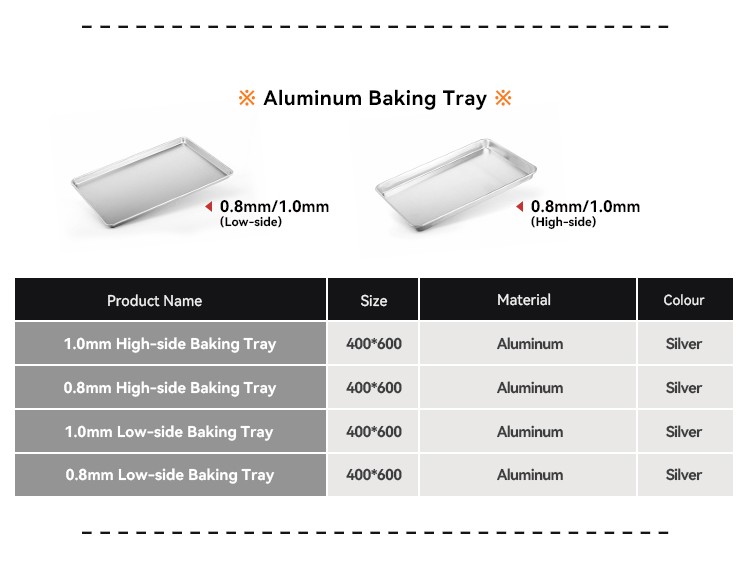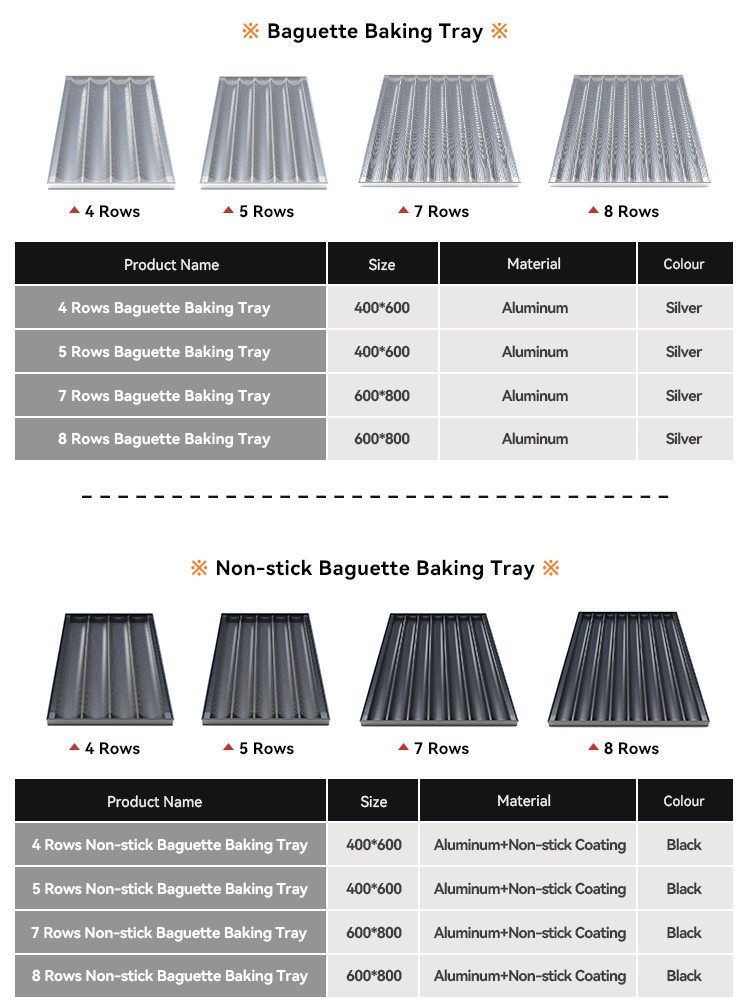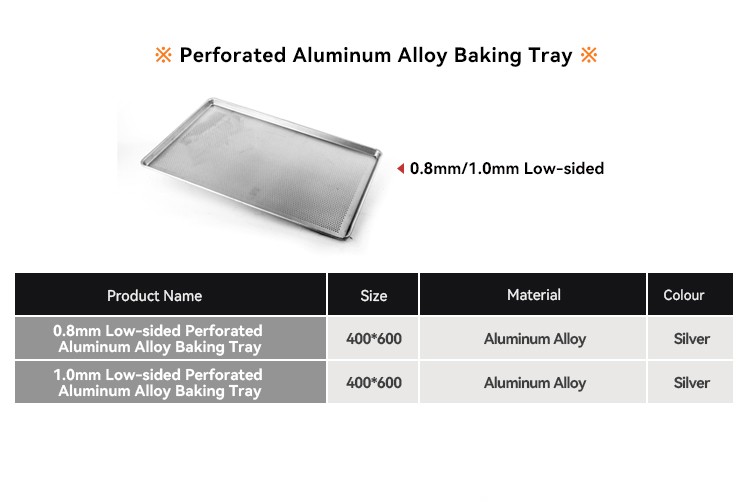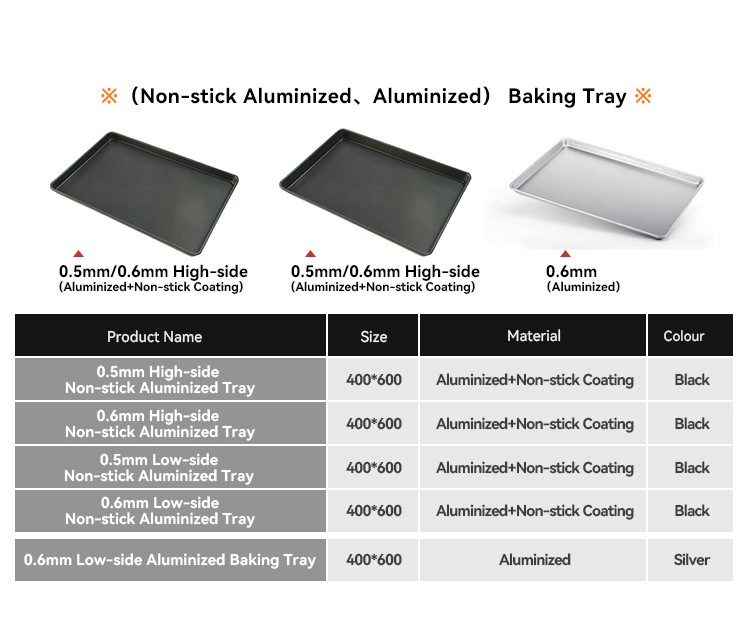Elegir el molde adecuado puede ser decisivo para el éxito de tus creaciones culinarias. Con opciones como moldes de aluminio, antiadherentes, perforados y aluminizados que inundan el mercado, es fácil sentirse abrumado. Esta guía detalla las características principales, las ventajas y los mejores usos de cada tipo para ayudarte a elegir el utensilio perfecto para tu cocina.
1. Moldes para hornear de aluminio:Ligero y económico
Ideal para: panaderos caseros, repostería informal, galletas y panes pequeños.
Ventajas:
• Conducción rápida del calor: garantiza una cocción uniforme para recetas rápidas.
•Asequible: ideal para principiantes o uso ocasional.
Contras:
•Propenso a deformarse: no apto para tareas pesadas.
•Riesgo de óxido: Evite la exposición prolongada a la humedad.
Consejo: Utilice papel pergamino para evitar que se pegue y alargar la vida útil de la sartén.

2. Sartenes de aluminio con revestimiento antiadherente: Liberación sin esfuerzo y limpieza fácil
Ideal para: pasteles, muffins y recetas bajas en grasa.
Ventajas:
•Perfección antiadherente: garantiza que los pasteles delicados se deslicen intactos.
•Limpieza rápida: Limpie con una esponja suave, ¡sin necesidad de frotar!
Contras:
•Sensibilidad al calor: Evite temperaturas superiores a 260 °C (500 °F).
•Durabilidad del revestimiento: utilice herramientas de silicona o de madera para evitar rayones.
Consejo profesional: reemplace las sartenes antiadherentes cada 2 o 3 años para un rendimiento óptimo.

3. Sartenes de aleación de aluminio perforado:Resultados nítidos para profesionales
Ideal para: cocinas comerciales, panes crujientes y carnes asadas.
Ventajas:
•Diseño de flujo de aire: promueve un dorado uniforme y el drenaje del aceite.
•Resistencia al calor: Soporta altas temperaturas sin deformarse.
Contras:
•Desafíos de limpieza: Los restos de comida pueden quedar atrapados en los agujeros.
Uso ideal: Combínalo con una bandeja de goteo para recoger el exceso de grasa durante el asado.

4. Moldes para hornear aluminizados: Durabilidad de grado industrial
Ideal para: panaderías, restaurantes y repostería de alta frecuencia.
Ventajas:
•Resistencia extrema al calor: soporta temperaturas superiores a 500 °C (932 °F).
•Larga vida útil: a prueba de óxido y construido para durar años.
Contras:
•Mayor costo: una inversión que vale la pena para usuarios intensivos.
¿Por qué elegir esto? El recubrimiento de acero aluminizado por inmersión en caliente ofrece una durabilidad inigualable para entornos industriales.

Cómo decidir: Factores clave a considerar
Frecuencia de uso:
Panaderos ocasionales → Sartenes de aluminio o antiadherentes.
Uso diario → Sartenes aluminizadas o perforadas.
Tipo de receta:
Pasteles delicados → Antiadherente.
Panes crujientes → Perforados.
Presupuesto: Priorice las sartenes aluminizadas para ahorrar a largo plazo en las cocinas comerciales.
Sección de preguntas frecuentes
P: ¿Puedo utilizar utensilios de metal en sartenes antiadherentes?
R: ¡No! Opte por herramientas de silicona o madera para proteger el revestimiento.
P: ¿Cómo limpio eficazmente una sartén perforada?
R: Remoje en agua tibia con jabón, luego use un cepillo para sacar los residuos de los agujeros.
P: ¿Las sartenes aluminizadas son seguras para los hornos domésticos?
R: Sí, pero su peso y tamaño pueden ser excesivos para los panaderos ocasionales.
online service